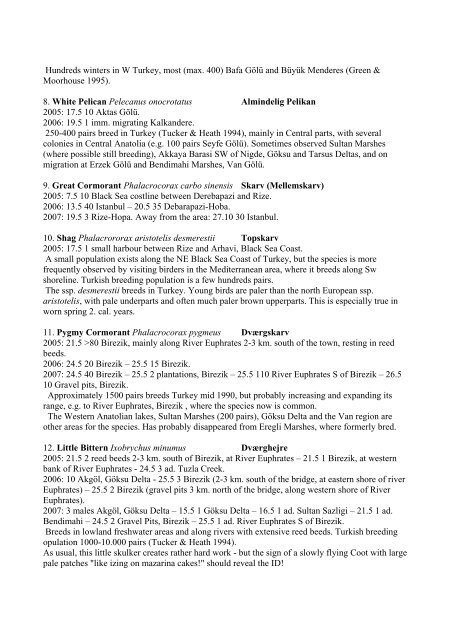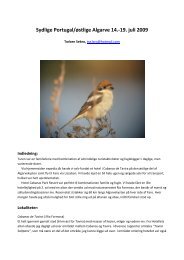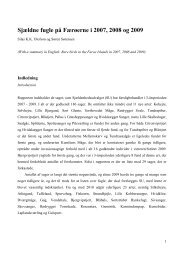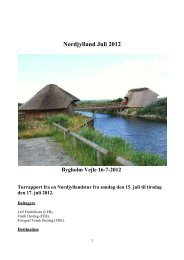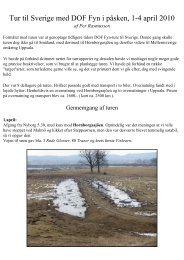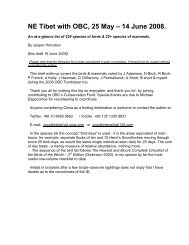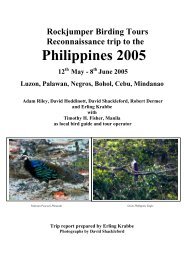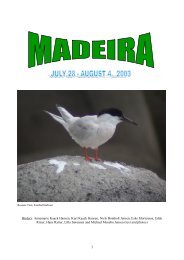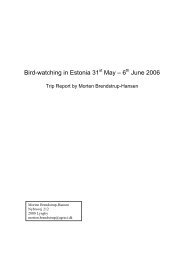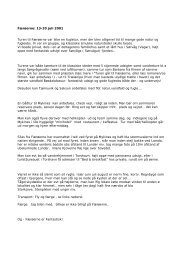TURKEY - a report from a birdwatching trip to Central ... - Netfugl.dk
TURKEY - a report from a birdwatching trip to Central ... - Netfugl.dk
TURKEY - a report from a birdwatching trip to Central ... - Netfugl.dk
Create successful ePaper yourself
Turn your PDF publications into a flip-book with our unique Google optimized e-Paper software.
Hundreds winters in W Turkey, most (max. 400) Bafa Gölü and Büyük Menderes (Green &<br />
Moorhouse 1995).<br />
8. White Pelican Pelecanus onocrotatus Almindelig Pelikan<br />
2005: 17.5 10 Aktas Gölü.<br />
2006: 19.5 1 imm. migrating Kalkandere.<br />
250-400 pairs breed in Turkey (Tucker & Heath 1994), mainly in <strong>Central</strong> parts, with several<br />
colonies in <strong>Central</strong> Ana<strong>to</strong>lia (e.g. 100 pairs Seyfe Gölü). Sometimes observed Sultan Marshes<br />
(where possible still breeding), Akkaya Barasi SW of Nigde, Göksu and Tarsus Deltas, and on<br />
migration at Erzek Gölü and Bendimahi Marshes, Van Gölü.<br />
9. Great Cormorant Phalacrocorax carbo sinensis Skarv (Mellemskarv)<br />
2005: 7.5 10 Black Sea costline between Derebapazi and Rize.<br />
2006: 13.5 40 Istanbul – 20.5 35 Debarapazi-Hoba.<br />
2007: 19.5 3 Rize-Hopa. Away <strong>from</strong> the area: 27.10 30 Istanbul.<br />
10. Shag Phalacrororax aris<strong>to</strong>telis desmerestii Topskarv<br />
2005: 17.5 1 small harbour between Rize and Arhavi, Black Sea Coast.<br />
A small population exists along the NE Black Sea Coast of Turkey, but the species is more<br />
frequently observed by visiting birders in the Mediterranean area, where it breeds along Sw<br />
shoreline. Turkish breeding population is a few hundreds pairs.<br />
The ssp. desmerestii breeds in Turkey. Young birds are paler than the north European ssp.<br />
aris<strong>to</strong>telis, with pale underparts and often much paler brown upperparts. This is especially true in<br />
worn spring 2. cal. years.<br />
11. Pygmy Cormorant Phalacrocorax pygmeus Dværgskarv<br />
2005: 21.5 >80 Birezik, mainly along River Euphrates 2-3 km. south of the <strong>to</strong>wn, resting in reed<br />
beeds.<br />
2006: 24.5 20 Birezik – 25.5 15 Birezik.<br />
2007: 24.5 40 Birezik – 25.5 2 plantations, Birezik – 25.5 110 River Euphrates S of Birezik – 26.5<br />
10 Gravel pits, Birezik.<br />
Approximately 1500 pairs breeds Turkey mid 1990, but probably increasing and expanding its<br />
range, e.g. <strong>to</strong> River Euphrates, Birezik , where the species now is common.<br />
The Western Ana<strong>to</strong>lian lakes, Sultan Marshes (200 pairs), Göksu Delta and the Van region are<br />
other areas for the species. Has probably disappeared <strong>from</strong> Eregli Marshes, where formerly bred.<br />
12. Little Bittern Ixobrychus minumus Dværghejre<br />
2005: 21.5 2 reed beeds 2-3 km. south of Birezik, at River Euphrates – 21.5 1 Birezik, at western<br />
bank of River Euphrates - 24.5 3 ad. Tuzla Creek.<br />
2006: 10 Akgöl, Göksu Delta - 25.5 3 Birezik (2-3 km. south of the bridge, at eastern shore of river<br />
Euphrates) – 25.5 2 Birezik (gravel pits 3 km. north of the bridge, along western shore of River<br />
Euphrates).<br />
2007: 3 males Akgöl, Göksu Delta – 15.5 1 Göksu Delta – 16.5 1 ad. Sultan Sazligi – 21.5 1 ad.<br />
Bendimahi – 24.5 2 Gravel Pits, Birezik – 25.5 1 ad. River Euphrates S of Birezik.<br />
Breeds in lowland freshwater areas and along rivers with extensive reed beeds. Turkish breeding<br />
opulation 1000-10.000 pairs (Tucker & Heath 1994).<br />
As usual, this little skulker creates rather hard work - but the sign of a slowly flying Coot with large<br />
pale patches "like izing on mazarina cakes!" should reveal the ID!


